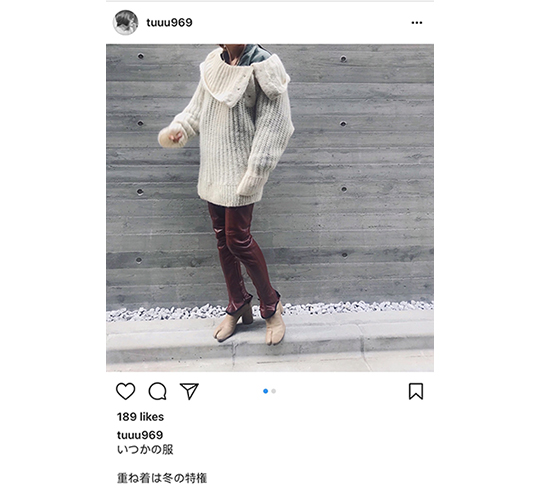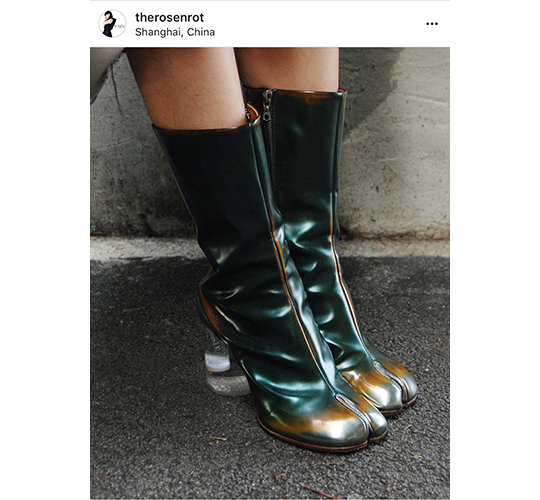The appeal of Margiela’s Tabi boot
Consumers with Cloven Hooves
For thirty years, Maison Martin Margiela, the luxury fashion label, has been producing a strange and unlikely form of footwear known as the Tabi boot. The shoe’s survival can be characterized in part as a happy accident: At the start of his career, Margiela simply did not have the funds to create a new style for the following seasons. If he wanted shoes in his collections, he had to continue on with the Tabis. It’s a good thing he did, for both his company and its fans. And the Tabi certainly has its fans.
The style is undoubtedly iconic, which, for some, may be difficult to fathom. It is easy to argue the hideousness of this shoe. With a splittoe resembling hooves, they are quite monstrous. But that is absolutely the point. To wear the Tabi is to momentarily evade the human form, which was likely its original appeal. But that alone could not have led the shoe triumphant into the 2010s. The fashion industry at large is now codependent on viewership. Where the industry once was in the hands of a specialized few, it now relies on, well…women on the Internet. The game was initially changed during the blogging revolution: Fashion bloggers demanded the attention of brands. Suburban nobodies quickly became insiders, the faces of the industry. The phenomenon became even more democratic with the increased popularity of Instagram, a platform that has since rendered the fashion blog inert. When the viewer enters the Instagram feed, the explore page, she does so with the expectation of bombardment by images that will dictate the trajectory of her own aesthetic. So what does this have to do with the Tabi? Everything. The viewer sees the Tabi once and is, in all likelihood, repulsed. But as more images surface, each depicting a young woman who, in all her staged glory, is one representation of a grander aesthetic purpose. The images come together to convey the message that this shoe is “it”: the object to covet. The message is gradually assimilated into the viewer’s aesthetic preferences, and the shoe develops its own following. This is how the avant-garde becomes trendy.

A trend is easy to distinguish by its rate of reproduction; our awareness of its influence is heightened every time we come into contact with its image. Our desires are hardly ever original. The products that interest us do so because we’ve already visualized ourselves in possession of them. We buy the Tabis because the Fashion Girls of the Internet have demonstrated our own potential. Which is not to say that the shoe is for everyone. It’s certainly not for the faint of heart. But that must be the reason for their present appeal because to possess the particular gumption it takes to wear these shoes must mean something. We mistake that meaning for individuality.
In actuality, the shoes themselves are their own kind of copy. The tabi, traditionally a Japanese sock, dates back to the fifteenth century, the split toe allowing for wear with various forms of thonged footwear. More recently, shoes known as the jika-tabi have surfaced in Japan, generally referring to rubber soled shoes worn by construction workers and farmers, their split-toe serving practical purposes relatated to the wearer’s labor. I think it’s fair to say that Margiela’s Tabis are not necessarily an original idea. However, he was the first to slap on a heel and make it fashion. The result was momentous for both his legacy and the industry at large. As Margiela himself said: “The Tabi boot is the most important footprint of my career: it’s recognizable, it still goes on after twenty-five years, and it has never been copied.” Unfortunately, the irony in this statement must be accounted for. Five years ago, Margiela could not foresee the inevitable. For its Fall 2018 collection, the design collective Vetements released its own take on the Tabi boot. The appropriative designs weren’t exactly innovative, but then of course, what is these days? If there’s nuance to the situation, fans of Margiela’s Tabis aren’t here for it. I was initially made aware of the Vetements catastrophe through the account @margielatab1, whose purpose is to archive all Tabi styles throughout the years. When Vetements debuted their Tabis, the manager of the account had much to say:
“Demna may be a fan it’s obvious basing his entire aesthetic on Margiela. No one touches the Tabi, everyone knows this. It’s a desperate attempt for sale. Unfortunately the majority of Vetements fans are hypebeasters who just want to keep up with the latest trend. They don’t know Margiela…”

Is it in poor taste? Sure. Especially considering the creative director Demna Gvasalia was fired from Margiela before taking his position at Vetements. But, this sort of thing can only be expected. The general consumer maintains no awareness as to the origins of the product; they do not demand an original, they demand what’s in. Neither fashion nor capitalism have ever upheld a strong moral code. I do think there’s a respectability in users like @margielatab1 objecting to the appropriation of designs and drawing attention to the historical importance of their favorite brands (though “They don’t know Margiela…” might be a tad exclusionary). And to be clear, the Vetements shoes are tacky. I wouldn’t be caught dead in them. In truth I couldn’t afford either pair. At present, the Tabi is still a luxury, but it’s only a matter of time until Forever 21 gets ahold of it. And that’s when the real drama begins, not in the comments of Instagram, but on the street; your average Joes walking around with cloven hooves, a sight to behold. 